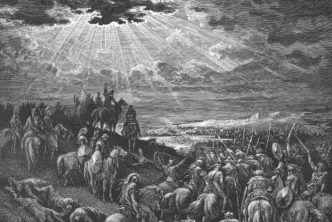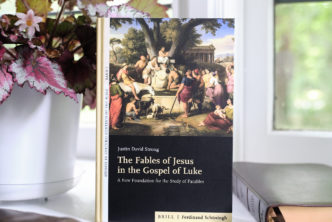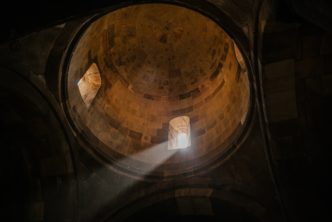
by Craig A. Evans
The last quarter-century has seen some impressive advances in biblical archaeology, especially relating to the time that we call the First Temple period (roughly 1000–600 BC) and the time of Jesus and the beginnings of the Christian movement (roughly the first century AD).
Regarding Israelite history, there are several items of interest that could be reviewed, but I shall limit myself to archaeological discoveries that directly relate to the Davidic kingdom and the Minimalism debate. As many readers probably know, it has been fashionable in Western scholarship to question the very existence of David. And even if such a figure actually existed, he did not rule over a kingdom whose boundaries stretched from the Sinai in the south to Lebanon in the north. Moreover—David or no David—scribal literacy in this period simply didn’t exist. The stories found in Samuel and Kings, we should assume, are little more than legends. So argue the Minimalists. But archaeology says otherwise.
The 1993 Tel Dan inscription in northern Israel dealt a serious blow to Minimalists. The eighth/ninth century BC Syrian inscription, hostile to Israel, refers to the “house of David.” Archaeologists and historians rightly recognized that the kingdom of Syria would not likely refer to a nonexistent dynasty. Some Minimalists suggested that the inscription was a fake, but the discovery of a second piece of the inscription in 1994 laid that suggestion to rest. Still fighting the evidence, some Minimalists wondered if the inscription should be read as “house of dōd,” that is, “house of the uncle.” But linguists find no merit in this suggestion. The Tel Dan inscription provides conclusive proof that David the king was a real person.
The ongoing excavations in the City of David in Jerusalem, led for many years by Eilat Mazar, granddaughter of the legendary Benjamin Mazar, has revealed a complex of tenth-century administrative buildings well beyond the needs of Jerusalem itself. The implication is that this complex was necessary for the administration of an empire, a political entity that stretched to the north, where the Tel Dan inscription was found.
In 2008 an ostracon with five lines of paleo-Hebrew was found at Qeiyafa, near Beth Shemesh, about twenty miles from Jerusalem. Ongoing work has confirmed that this was a fortified Israelite (not Canaanite or Philistine) city dating as early as the eleventh century BC. Although it is debated, the fourth line may refer to the establishment of a king. If so, the reference may be to Saul, Israel’s first king and David’s immediate predecessor. In any event, the language is consistent with the language of Samuel and shows that its stories about the exploits of Israel’s kings could well have been recorded in the time of Samuel, Saul, and David, even if the final product was edited and completed at a much later time.
Gospel Minimalists and Jesus Mythicists—like their Old Testament counterparts—also have met with challenges in recent years. The archaeological evidence in Galilee and elsewhere in Israel has shown again and again that the New Testament Gospels exhibit verisimilitude—that is, they speak of real people, real places, and real events. In short, the Gospels are not the stuff of myth.
The Cynic hypothesis (the proposal that Jesus came under the influence of Cynics living in Sepphoris) was all the rage in the 1980s and 1990s, but it has been demolished by the archaeology of Sepphoris, a city a few miles from Nazareth. It turns out that the Sepphoris of the time of Jesus was thoroughly Jewish. There are many ritual bathing pools, stone water jugs, kosher animal remains, and the complete absence of pagan artifacts.
Those who claim that Jesus could not possibly have traveled throughout Galilee, proclaiming his message, have also been refuted. Roads, including major highways, crisscrossed Galilee, which facilitated travel and commerce alike. Galilean commitment to Torah observance is witnessed by the ubiquity of ceramic produced in Jewish Kefar Hananya, by the remains of at least ten synagogues that pre-date AD 70, by the two decorated synagogue stones that indicate allegiance to the temple in Jerusalem, and by the absence of non-kosher animal remains. The idea entertained by some scholars in the twentieth century that Galilee was largely Gentile has now been refuted. The Galilean Jews were indeed Jewish, and many of them originally came from Judea and settled in Galilee during the Hasmonean period.
Moreover, field surveys strongly support Josephus’s claim that there were 204 villages and cities in Galilee, and that for Jesus and his disciples to preach in all or most of these settlements would indeed require about one year or perhaps eighteen months of itinerancy, which is what the Gospel of Mark seems to imply.
Archaeology continues to support and shed light on the biblical narratives.
 Craig A. Evans (PhD, Claremont) is John Bisagno Distinguished Professor of Christian Origins at Houston Baptist University. He is the author of several books on Jesus, archaeology, and the Dead Sea Scrolls. His current project is Jesus and the Manuscripts, which will assess all important writings — within or outside the canon — that potentially shed light on Jesus.
Craig A. Evans (PhD, Claremont) is John Bisagno Distinguished Professor of Christian Origins at Houston Baptist University. He is the author of several books on Jesus, archaeology, and the Dead Sea Scrolls. His current project is Jesus and the Manuscripts, which will assess all important writings — within or outside the canon — that potentially shed light on Jesus.
Originally published in Didaktikos: Journal of Theological Education (November 2017). Biblical studies and theological faculty can receive Didakitkos for free. Visit DidaktikosJournal.com.






[…] via Biblical Archaeology: Real People, Real Events — theLAB […]
Fascinating data. Thank you.
Very interesting.
Not directly related, but now that king David is mentioned, what are we to think of the Shroud of Turin, and the DNA that was extracted from it?
The supposedly face cloth (found in another city) matches the stain marks of those in the Turin Shroud.
What is baffling, is that the DNA found is supposed to be of the Druze ethnic group, which does inhabit parts of the Nazareth region in Israel.
Some Israelites say that Druzes are Jews that were forced to say they were Muslims due to thread of death.
Druzes themselves say that their origin goes back to Ancient Egypt.
The scientists that worked the DNA expected to have some ties to the Davidic Kingdom line, but now they are baffled.
Some think that the Shroud of Turin is fake, but a special device used by Nasa, showed that it is not a paint, but more of a scan caused by some form of energy, which theoretically could not be produced at the time that the cloth is dated (about the time of Christ’s death) because that technology did not exist.
Any comments?